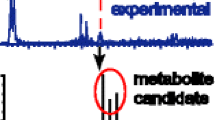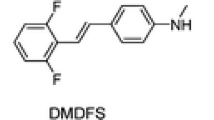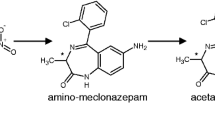Summary
In this study, we have described a novel approach for determining the metabolic scheme of diferuloylmethane (curcumin) in mouse and human liver microsomal preparations using a hybrid quadrupole linear ion trap mass spectrometer coupled with liquid chromatography for the detection of new metabolites. Application of various acquisition modes allowed targeted searches for metabolites with high sensitivity and selectivity using information of the mass spectral fragmentation properties of curcumin. Structural assignments for metabolites previously reported in the literature were made with confidence using the described approach. In addition, we identified curcumin metabolites that had not previously been reported, such as curcumin fcglucuronide andO-demethylated derivatives. The major pathways of curcumin metabolismin vitro have been summarized. Finally, very similar metabolic pathways of curcumin were observed in human and mouse microsomes.
Similar content being viewed by others
References
Gafner S., Lee S-K., Guendet M., Berthelemy S., Vergnes L., Labidalle S., Mehta R.G., Boone C.W., Pezzuto J.M. (2004): Biologie evaluation of curcumin and structural derivatives in cancer chemoprevention model systems. Phytochemistry, 65, 2849–2859.
Shishodia S., Sethi G., Aggarwal B.B. (2005): Curcumin: getting back to the roots. Ann. NY Acad. Sci., 1056, 206–217.
Sarkat F.H., Li Y. (2004): Cell signaling pathways altered by natural chemopreventive agents. Mutat. Res., 555, 53–64.
Campbell F.C., Collett G.P. (2005): Chemopreventive properties of curcumin. Future Oncol., 1, 405–414.
Sharma R.A., Gescher A.J., Steward W.P. (2005): Curcumin: the story so far. Eur. J. Cancer, 41, 1955–1968.
Aggarwal B.B., Shishodia S. (2006): Molecular targets of dietary agents for prevention and therapy of cancer. Biochem. Pharmacol., 71, 1397–1421.
Maheshwari R.K., Singh A.K., Gaddipati J., Srimal R.C. (2006): Multiple biological activities of curcumin: a short review. Life Sci., 78, 2081–2087.
Cheng A.L., Hsu CH., Lin J.K., Hsu M.M., Ho Y.F., Shen T.S., Ko J.Y., Lin J.T, Lin B.R., Ming-Shiang W., Yu H.S., Jee S.H., Chen G.S., Chen T.M., Chen C.A., Lai M.K., Pu Y.S., Pan M.H., Wang Y.J., Tsai C.C., Hsieh C.Y. (2001): Phase I clinical trial of curcumin, a chemopreventive agent, in patients with high-risk or pre-malignant lesions. Anticancer Res., 21, 2895- 2900.
Li L., Braiteh F.S., Kurzrock R. (2005): Liposome-encapsulated curcumin —in vitro andin vivo effects on proliferation, apoposis, signaling, and angiogenesis. Cancer, 104, 1322–1331.
Ireson C., Orr S., Jones J.L., Verschoyle R., Kim C-K., Luo J-L., Howells L., Plummer S., Williams M., Steward W.P., Gerscher A. (2001): Characterization of metabolites of the chemopreventive agent curcumin in human and rat hepatocytes and in the ratin vivo, and evaluation of their ability to inhibit phorbol ester-induced prostaglandin E2 production. Cancer Res., 61, 1058–1064.
Sharma R.A., McLelland H.R., Hill K.A.. Ireson C.R., Euden S.A., Manson M.M., Pirmohamed M., Marnett L.J., Gerscher A.J. Steward W.P. (2001): Pharmacodynamic and pharmacokinetic study of oralCurcuma extract in patients with colorectal cancer. Clin. Cancer Res., 7, 1894–1900.
Ireson C.R., Jones D.J.L., Orr S., Coughtrie M.W., Boocock D.J., Williams M.L., Farmer P.B., Steward W.P., Gescher A.J. (2005): Metabolism of the cancer chemopreventive agent curcumin in human and rat intestine. Cancer Epidemiol Biomarkers Prev., 11, 97–104.
Pan M-H., Huang T-M., Un J-K. (2000): Biotransformation of curcumin through reduction and glucuronidation in mice. Drug Metab. Dispos., 27, 486–494.
Asai A., Miyazawa T. (2000): Occurrence of orally administered curcuminoid as glucuronide and glucuronide/sulphate conjugates in rat plasma. Life Sci., 67, 2785–2793.
Garcea G., Berry D.P., Jones D.J.L., Singh R., Dennison A.R., Farber P.B., Sharma R.A., Steward W.P., Gescler A.J. (2005): Consumption of the putative chemopreventive agent curcumin by cancer patients: assessment of curcumin levels in the colorectum and their pharmacodynamic consequences. Cancer Epidemiol. Biomarkers Prev., 14, 120–125.
Hopfgartner G., Husser C., Zell M. (2003): Rapid screening and characterization of drug metabolites using a new quadrupole-linear ion trap mass spectrometer. Rapid Commun. Mass Spectrom., 38, 138–150.
Chowdhury H., Walia S., Saxena V. (2000): Isolation, characterization and insect growth inhibitory activity of major turmeric constituents and their derivatives against Schistocerca gregaria (Forsk) andDysdercus koenigii (Walk). Pest Manag. Sci., 56, 1086–1092.
Mauriala T., Chauret N., Oballa R., Nicoll-Griffith D.A., Bateman K.P. (2005): A strategy for identification of drug metabolites from dried blood spots using triple-quadrupole/linear ion trap hybrid mass spectrometry. Rapid Commun. Mass Spectrom., 19, 1984–1992.
King R., Fernandez-Metzler C. (2006): The use of QTrap technology in drug metabolism. Curr. Drug Metab., 7, 541–545.
Xia Y-Q., Miller J.D., Bakhtiar R., Franklin R.B., Liu D.Q. (2003): Use of a quadrupole linear ion trap mass spectrometer in metabolite identification and bioanalysis. Rapid Commun. Mass Spectrom., 17: 1137–1145.
Author information
Authors and Affiliations
Corresponding author
Rights and permissions
About this article
Cite this article
Tamvakopoulos, C., Sofianos, Z.D., Garbis, S.D. et al. Analysis of thein vitro metabolites of diferuloylmethane (curcumin) by liquid chromatography — tandem mass spectrometry on a hybrid quadrupole linear ion trap system: newly identified metabolites. Eur. J. Drug Metabol. Pharmacokinet. 32, 51–57 (2007). https://doi.org/10.1007/BF03190990
Received:
Issue Date:
DOI: https://doi.org/10.1007/BF03190990




